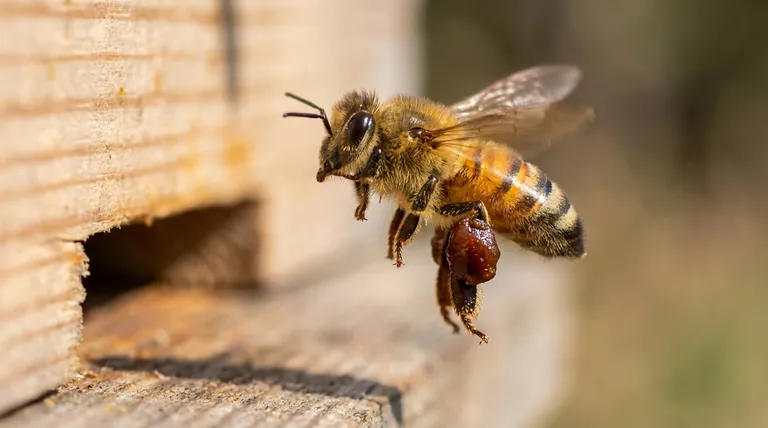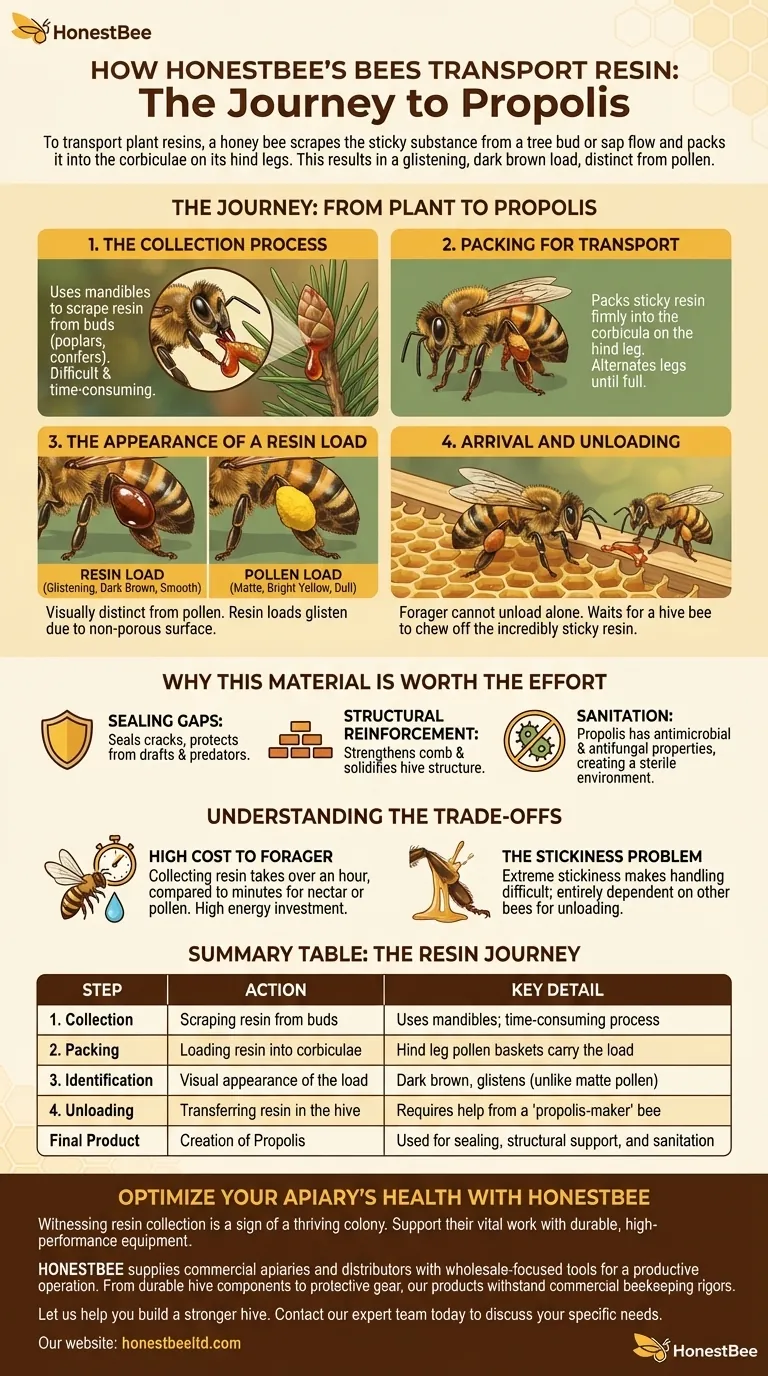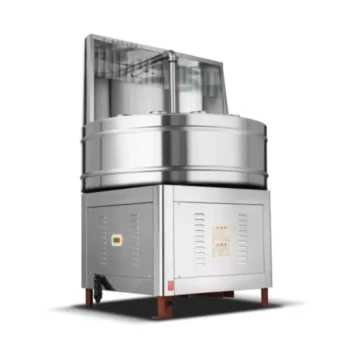To transport plant resins, a honey bee scrapes the sticky substance from a tree bud or sap flow and packs it into the corbiculae, or pollen baskets, on its hind legs. This specialized task results in a glistening, often dark brown load that is distinct from the matte appearance of a pollen pellet. The resin is then carried back to the hive to be processed into propolis.
The method bees use to carry resin is a critical part of a larger strategy: creating propolis. Understanding this transport process reveals not only the bee's physical capabilities but also the colony's sophisticated approach to hive sanitation and structural integrity.

The Journey of Resin: From Plant to Propolis
The collection and transport of resin is a highly specialized task performed by a small percentage of the colony's foragers. The entire process is laborious and requires precision at every step.
Step 1: The Collection Process
The forager bee begins by using its mandibles (jaws) to scrape and pry off a small piece of sticky resin from a plant source, most commonly from the buds of trees like poplars and conifers. This is a difficult, time-consuming effort.
Step 2: Packing for Transport
Once a manageable piece is loosened, the bee uses its front and middle legs to manipulate the resin. It transfers the sticky substance from its mandibles and packs it firmly into the corbicula, or pollen basket, on one of its hind legs. It repeats this process, often alternating legs, until it has a full load.
Step 3: The Appearance of a Resin Load
A load of resin is visually distinct from a load of pollen. While pollen loads are typically bright yellow or orange with a dull, matte finish, resin loads are usually a rich, chestnut brown or dark color. Most importantly, they glisten in the sunlight due to the resin's smooth, non-porous surface.
Step 4: Arrival and Unloading at the Hive
Upon returning to the hive, the forager cannot unload the incredibly sticky resin by itself. It must wait for a "propolis-maker" hive bee to assist. This hive bee will chew the resin directly off the forager's leg and then apply it where it is needed.
Why This Material is Worth the Effort
Transporting resin is a high-effort, low-volume task compared to collecting nectar or pollen. The colony undertakes this work because the end product, propolis, is essential for its survival.
The Purpose of Propolis
Also known as "bee glue," propolis is a mixture of plant resins, beeswax, and saliva. The bees use it for several critical functions:
- Sealing Gaps: It is used to seal unwanted cracks and openings in the hive, protecting the colony from drafts and predators.
- Structural Reinforcement: Bees use it to strengthen the comb and solidify the hive's internal structure.
- Sanitation: Propolis has powerful antimicrobial and antifungal properties. Bees coat the entire interior surface of the hive with a thin layer of it, creating a sterile environment that inhibits disease.
Understanding the Trade-offs
While essential, the collection of resin presents unique challenges that are not present with other foraging tasks.
The High Cost to the Forager
Collecting resin is one of the most difficult jobs a forager can perform. The process of scraping and packing the sticky material can take over an hour, compared to just a few minutes for a load of nectar or pollen. This represents a significant investment of time and energy for the bee.
The Stickiness Problem
The extreme stickiness of the resin makes it very difficult to handle. Not only is it hard to collect, but as mentioned, the forager is entirely dependent on other bees to help unload it. This co-dependent process highlights the social complexity of the hive.
What This Behavior Tells Us
Observing how bees transport resin provides a deeper insight into the colony's priorities and resource management.
- If you are a beekeeper: Recognizing a glistening, dark load on a bee's leg means your colony is actively fortifying its hive and managing its health, a strong sign of a resourceful and well-functioning colony.
- If you are an observer of nature: This behavior showcases the bee's remarkable ability to manipulate difficult materials and the colony's collective strategy for creating a sterile and secure home.
Ultimately, the journey of a single drop of resin reveals the incredible ingenuity honey bees employ to maintain the health and integrity of their colony.
Summary Table:
| Step | Action | Key Detail |
|---|---|---|
| 1. Collection | Scraping resin from buds | Uses mandibles; time-consuming process |
| 2. Packing | Loading resin into corbiculae | Hind leg pollen baskets carry the load |
| 3. Identification | Visual appearance of the load | Dark brown, glistens (unlike matte pollen) |
| 4. Unloading | Transferring resin in the hive | Requires help from a 'propolis-maker' bee |
| Final Product | Creation of Propolis | Used for sealing, structural support, and sanitation |
Optimize Your Apiary's Health with the Right Supplies
Witnessing your bees collect resin is a sign of a thriving, health-conscious colony. Support their vital work with durable, high-performance equipment designed for commercial success.
HONESTBEE supplies commercial apiaries and beekeeping equipment distributors with the wholesale-focused tools needed for a productive and healthy operation. From durable hive components to protective gear, our products are built to withstand the rigors of commercial beekeeping.
Let us help you build a stronger hive.
Contact our expert team today to discuss your specific needs and discover how our supplies can contribute to the integrity and success of your operation.
Visual Guide

Related Products
- HONESTBEE Advanced Ergonomic Stainless Steel Hive Tool for Beekeeping
- Professional Dual-End Stainless Steel Hive Tool for Beekeeping
- Professional Wide Blade Honey Scraper for Beekeeping and Honey Processing
- Professional Long-Handled Silicone Honey Scraper for Beekeeping
- Honey Concentrating Vacuum Heating Thickening Machine Dehumidifier for Honey
People Also Ask
- What are the basic tools for beekeeping? Essential Starter Kit for Safe & Successful Hive Management
- Why is it important to compare the progress of different hives? A Beekeeper's Key Diagnostic Tool
- What tools are used for cleaning frames? A Beekeeper's Simple 4-Tool Guide
- What are the features of a regular hive tool? The Essential Multi-Tool for Every Beekeeper
- How is a hive tool used for scraping and cleaning? Master Hive Maintenance for a Healthy Colony



















